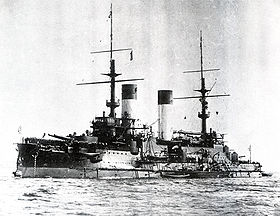Knyaz Suvorov
|
|
|
|---|---|
 Ship of the line Knjas Suvorov 1904 in Kronstadt |
|
| Overview | |
| Type | Ship of the line |
| units | 5 |
| Shipyard | |
| Keel laying | July 1901 |
| Launch | September 1902 |
| delivery | September 1904 |
| Namesake | Prince Suvorov |
| period of service |
1904-1905 |
| Whereabouts | May 27, 1905 sunk near Tsushima |
| Technical specifications | |
| displacement |
13,516 ts ; |
| length |
121 m |
| width |
23.3 m |
| Draft |
8.00 m |
| crew |
788 men |
| drive |
12 Belleville boilers , |
| speed |
17.5 kn |
| Range |
2,590 nm at 10 kn |
| Armament |
|
| Coal supply |
1,545 ts of coal |
| Armor |
|
The Knjas Suworow ( Russian Князь Суворов ) was a ship of the line of the Imperial Russian Navy , the fourth of five ships of the Borodino class . The ship was named after the Russian generalissimo , prince (Russian Knjas, since 1799) Alexander Wassiljewitsch Suworow (1730-1800). After a march of over 18,000 nm with two sister ships, it was sunk on May 27, 1905 in the naval battle of Tsushima .
The Borodino class
The Borodino class was based on the plans of the Zessarevich, built in France 1899–1901 . When the construction contract was signed, the Russian naval command insisted that five more ships of the same type be built in Russia and modified if necessary so that they would meet the requirements of the Russian navy. Accordingly, from 1899 to 1905, the ships of the Borodino class were built in Russian shipyards: Borodino , Emperor Alexander III. , Oryol , Knjas Suvorov and Slava .
Like the Zessarewitsch , these ships also suffered from the fact that their center of gravity was too high, the hull walls in the so-called tumble home design showed inwards above the waterline, the longitudinal bulkhead running in the middle of the hull caused the danger of capsizing, and the low belt armor was pushed underwater with a full combat load. The casemate guns were so low that they were unusable in rough seas. In addition, the ships, despite their greater weight, had weaker engines than the Zessarewitsch . All three ships of the class sunk at Tsushima capsized before sinking. The ships are therefore regarded by some shipbuilding experts as the worst battleships ever built (Preston 2002).
history
Tsushima
The Knjas Suworow was laid down in 1901 at the Baltic Works in St. Petersburg . She was launched in September 1902 and was completed in September 1904, put into service and assigned to the Second Pacific Squadron under Vice Admiral Roschestwensky with her sister ships (with the exception of the not yet completed Slawa ) . Roshestvensky took the Knyaz Suvorov as his flagship . On October 15, 1904, Roschestvensky's fleet embarked on an eight-month voyage over 18,000 nautical miles to East Asia.
The Knjas Suvorov , under the command of Kpt. Ignatius, was quickly and severely damaged in the naval battle of Tsushima on May 27, 1905. As the lead ship of the Russian battle line, she continually received significant hits from the Japanese battle fleet. One hit hit the bridge and seriously wounded the commanding admiral, so that from this point on the fleet was no longer in command, because the remaining ships were not given a signal about this.
Badly hit, she had to leave the battle line and handed the wounded Admiral Roschestvensky to a torpedo boat so that he could be brought to safety. In the further course of the battle, the ship received more heavy hits and lost contact with the Russian battle line. For a short time the ship got caught between the squadrons and was accidentally shot at by the Russian ships who thought it was a damaged Japanese armored cruiser. Finally, the ship, like the auxiliary cruiser Kamchatka, which had remained behind to cover it, was finally hit by Japanese torpedo boats, capsized and sank.
literature
- Igor Bunitsch: Knyaz Suvorov. Istoricheskaya Chronicle. Saint Petersburg 2003 (Бунич Игорь: Князь Суворов. Историческая хроника. Санкт-Петербург 2003)
- RA Burt: Japanese Battleships, 1897-1945
- Julian Corbett : Maritime Operations in The Russo-Japanese War 1904–1905. 1994, ISBN 1-55750-129-7 .
- Tony Gibbons: The Complete Encyclopedia of Battleships , Crescent Books, New York, 1983 ISBN 0-517-37810-8
- Richard A. Hough: The Fleet That Had To Die , Ballantine Books, New York 1960
- Hugh Lyon: The Encyclopedia of the World's Warships , Chartwell Books, 1985 ISBN 0-89009-780-1
- S. McLaughlin: "Aboard the Orel at Tsushima", in Warship 2005 , Conways Maritime Press 2005
- Alexei Novikoff-Priboy : Tsushima , George Allen & Unwin Ltd., London 1936
- Constantine Pleshakov : The Tsar's Last Armada: Epic Voyage to the Battle of Tsushima , 2002 ISBN 0-46505-792-6
- Antony Preston: World's Worst Warships , Conways Maritime Press 2002
- John Roberts, HC Timewell, Roger Chesneau (ed.), Eugene M. Kolesnik (ed.): Warships of the World 1860 to 1905 - Volume 2: USA, Japan and Russia , Bernard & Graefe Verlag, Koblenz, 1983, ISBN 3- 7637-5403-2
- VM Tomitch: Warships of the Imperial Russian Navy, Vol. 1: Battleships , 1968
- Denis and Peggy Warner: The Tide at Sunrise, A History of the Russo-Japanese War 1904-1905 , 1975 ISBN 0-7146-5256-3